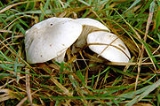
Clitopilus prunulus
Encyclopedia
Clitopilus prunulus, commonly known as the miller or the sweetbread mushroom, is an edible pink-spored basidiomycete mushroom found in grasslands in Europe. It has a grey to white cap and decurrent gills.
is initially convex when young, but in maturity flattens out, usually with a shallow central depression. It is white or light gray or yellow, sticky when moist, and 3 to 10 cm (1.2 to 3.9 in) in diameter with a characteristic feel to the touch of chamois skin. The gills are decurrent
in attachment to the stipe, spaced together rather closely, and whitish, although they often develop a pinkish hue in age. The stipe
is 3 to 8 cm (1.2 to 3.1 in) long x 4–15 mm thick, and white. This mushroom has a mealy odor, somewhat like cucumber. The spore print
is pink. Spores are 9–12 x 5–6.5 µm
. C. prunulus may be found growing on the ground in hardwood and coniferous woods in the summer and fall.
The variant C. prunulus var. orcellus has a slimy cap and white colors.
per gram of crushed tissue. C. prunulus contains the volatile
compound 1-octen-3-ol
, making it unpalatable to the coastal Pacific Northwest banana slug, Ariolimax columbianus.
(Fool's Funnel). The Miller has pink spores whereas Fools Funnel are white, the gills of the miller are more easily pulled away, and the Miller smells of raw pastry. The Miller also prefers woodland whereas Fools Funnel is a grassland species.
Description
The capPileus (mycology)
The pileus is the technical name for the cap, or cap-like part, of a basidiocarp or ascocarp that supports a spore-bearing surface, the hymenium. The hymenium may consist of lamellae, tubes, or teeth, on the underside of the pileus...
is initially convex when young, but in maturity flattens out, usually with a shallow central depression. It is white or light gray or yellow, sticky when moist, and 3 to 10 cm (1.2 to 3.9 in) in diameter with a characteristic feel to the touch of chamois skin. The gills are decurrent
Decurrent
Decurrent is a term used in botany and mycology to describe plant or fungal parts that extend downward.In botany, the term is most often applied to leaf blades that partly wrap or have wings around the stem or petiole and extend down along the stem...
in attachment to the stipe, spaced together rather closely, and whitish, although they often develop a pinkish hue in age. The stipe
Stipe (mycology)
thumb|150px|right|Diagram of a [[basidiomycete]] stipe with an [[annulus |annulus]] and [[volva |volva]]In mycology a stipe refers to the stem or stalk-like feature supporting the cap of a mushroom. Like all tissues of the mushroom other than the hymenium, the stipe is composed of sterile hyphal...
is 3 to 8 cm (1.2 to 3.1 in) long x 4–15 mm thick, and white. This mushroom has a mealy odor, somewhat like cucumber. The spore print
Spore print
thumb|300px|right|Making a spore print of the mushroom Volvariella volvacea shown in composite: mushroom cap laid on white and dark paper; cap removed after 24 hours showing pinkish-tan spore print...
is pink. Spores are 9–12 x 5–6.5 µm
Micrometre
A micrometer , is by definition 1×10-6 of a meter .In plain English, it means one-millionth of a meter . Its unit symbol in the International System of Units is μm...
. C. prunulus may be found growing on the ground in hardwood and coniferous woods in the summer and fall.
The variant C. prunulus var. orcellus has a slimy cap and white colors.
Volatile compounds
The cucumber odor of this species has been attributed to trans-2-nonenal, which is present at a concentration of 17 µgMicrogram
In the metric system, a microgram is a unit of mass equal to one millionth of a gram , or 1/1000 of a milligram. It is one of the smallest units of mass commonly used...
per gram of crushed tissue. C. prunulus contains the volatile
Volatility (chemistry)
In chemistry and physics, volatility is the tendency of a substance to vaporize. Volatility is directly related to a substance's vapor pressure. At a given temperature, a substance with higher vapor pressure vaporizes more readily than a substance with a lower vapor pressure.The term is primarily...
compound 1-octen-3-ol
1-Octen-3-ol
1-Octen-3-ol, octenol for short , is a chemical that attracts biting insects such as mosquitos. It is contained in human breath and sweat, and it was once believed that insect repellent DEET works by blocking the insects' octenol odorant receptors.Octenol is used in combination with carbon dioxide...
, making it unpalatable to the coastal Pacific Northwest banana slug, Ariolimax columbianus.
Similar looking species
The poisonous Clitocybe rivulosaClitocybe rivulosa
Clitocybe rivulosa, commonly known as the false champignon or fool's funnel, is a poisonous basidiomycete fungus of the large genus Clitocybe. One of several species similar in appearance, it is a small white funnel-shaped toadstool widely found in lawns, meadows and other grassy areas in Europe...
(Fool's Funnel). The Miller has pink spores whereas Fools Funnel are white, the gills of the miller are more easily pulled away, and the Miller smells of raw pastry. The Miller also prefers woodland whereas Fools Funnel is a grassland species.

